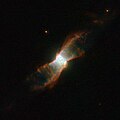Сурет:NGC 6881 HST.jpg
Навигацияға өту
Іздеуге өту
NGC_6881_HST.jpg (532 × 532 пиксел, файл өлшемі: 129 КБ, MIME түрі: image/jpeg)
Файл тарихы
Файл сол кезде қалай көрінгенін көру үшін күн/уақыт дегенге басыңыз.
| Күн/Уақыт | Нобай | Өлшемдер | Қатысушы | Пікір | |
|---|---|---|---|---|---|
| қазіргі | 14:13, 2019 ж. желтоқсанның 31 |  | 532 × 532 (129 КБ) | BevinKacon | actual size from source |
| 17:18, 2012 ж. наурыздың 12 |  | 1280 × 1280 (266 КБ) | Jmencisom |
Файл қолданылуы
Бұл файлды мына бет қолданады:
Глобалды файл қолданылуы
Бұл файл келесі басқа уикилерде қолданылады:
- ar.wikipedia.org жобасында қолданылуы
- az.wikipedia.org жобасында қолданылуы
- beta.wikiversity.org жобасында қолданылуы
- be.wikipedia.org жобасында қолданылуы
- bs.wikipedia.org жобасында қолданылуы
- ce.wikipedia.org жобасында қолданылуы
- de.wikipedia.org жобасында қолданылуы
- diq.wikipedia.org жобасында қолданылуы
- en.wikipedia.org жобасында қолданылуы
- en.wikiversity.org жобасында қолданылуы
- eo.wikipedia.org жобасында қолданылуы
- eu.wikipedia.org жобасында қолданылуы
- fa.wikipedia.org жобасында қолданылуы
- fr.wikipedia.org жобасында қолданылуы
- hr.wikipedia.org жобасында қолданылуы
- lb.wikipedia.org жобасында қолданылуы
- mk.wikipedia.org жобасында қолданылуы
- my.wikipedia.org жобасында қолданылуы
- nl.wikipedia.org жобасында қолданылуы
- pl.wikipedia.org жобасында қолданылуы
- pt.wikipedia.org жобасында қолданылуы
- ru.wikipedia.org жобасында қолданылуы
- sk.wikipedia.org жобасында қолданылуы
- sr.wikipedia.org жобасында қолданылуы
- tr.wikipedia.org жобасында қолданылуы
- tt.wikipedia.org жобасында қолданылуы
- uk.wikipedia.org жобасында қолданылуы
- uz.wikipedia.org жобасында қолданылуы
- www.wikidata.org жобасында қолданылуы
